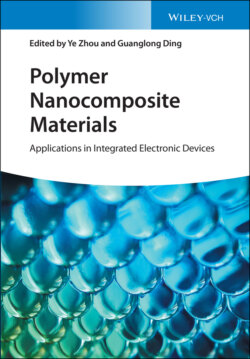Читать книгу Polymer Nanocomposite Materials - Группа авторов - Страница 19
1.5 Synthesis of Polymer Nanocomposites
ОглавлениеIn the synthesis of PNCs, it is necessary to uniformly distribute the fillers into matrix in order to realize the functions of fillers. However, due to the fact that the fillers are nanoscale, the uniform dispersion is much different from that of the microscale fillers, which is mainly manifested in the following aspects. First, if the filling operation is carried out according to the volume fraction, much more nanometer fillers than the microfillers are required at the same volume fraction. Therefore, the nanoparticles in matrix are very crowded with greater van der Waals and electrostatic interactions between the particles, making it difficult to distribute evenly. Second, the anisotropic nanofillers have a very high aspect ratio, which makes them more prone to agglomerate. For example, monolayer graphene has aspect ratio of about 104, so they tend to reduce their surface energy by π–π stacking. Third, a large amount of nanofillers with huge surface area is loaded in the polymer matrix, which will produce a large interface area and change the overall performances of the PNC. Therefore, the decisive step in the synthesis of PNCs is the uniform dispersion of nanofillers in polymer matrix. As shown in Table 1.2, the common methods to disperse nanofillers and prevent the aggregation of nanoparticles by using external energy are summarized.
Table 1.2 Summary of common methods for synthesis of polymer nanocomposites.
| Technique | Suitable filler | Suitable matrix | Solvent | Controlling factors |
|---|---|---|---|---|
| Ultrasonication-assisted solution mixing | All types | Liquid or viscous monomers or oligomers of thermosets | Required | Sonication power and time |
| Shear mixing | Nanosheets | Liquid or viscous monomers or oligomers of thermosets | Required | Shapes of the rotor blades, rotating speed and time |
| Three roll milling | Nanosheets and nanotubes | Liquid or viscous monomers or oligomers of thermosets | Not required | Speed of roller, gap between adjacent roller |
| Ball milling | All types | Liquid or solid thermoplastics and thermosets | Not required | Time of milling, ball size, rotating speed, ball/nanofiller ratio |
| Double-screw extrusion | All types | Solid thermoplastics | Not required | Processing temperature, screw configuration, rotation speed |
| In situ synthesis | All types | Liquid or viscous monomers or oligomers of thermosets | Required | Chemical reaction conditions, temperature, condensation rate |
